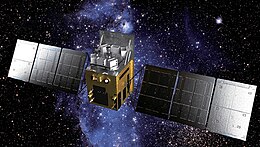 Rendering of HXMT | |
| Mission type | Astronomy |
|---|---|
| Operator | CAS / IHEP |
| COSPAR ID | 2017-034A |
| SATCAT no. | 42758[1] |
| Website | http://www.hxmt.org/ |
| Mission duration | Elapsed: 7 years, 21 days[2] |
| Spacecraft properties | |
| Launch mass | 2,800 kg (6,200 lb)[2] |
| Dimensions | 2.0 × 2.0 × 2.8 m (6.6 × 6.6 × 9.2 ft)[2] |
| Start of mission | |
| Launch date | June 14, 2017, 03:00:00 UTC [2] |
| Rocket | Long March 4B[2] |
| Launch site | 603 Launch Pad of the LC43 Launch Complex, Jiuquan Satellite Launch Center[2] |
| Orbital parameters | |
| Reference system | Geocentric[1] |
| Regime | Low Earth[1] |
| Semi-major axis | 6,920 km (4,300 mi)[1] |
| Eccentricity | 0.0006597[1] |
| Perigee altitude | 545 km (339 mi)[1] |
| Apogee altitude | 554.1 km (344.3 mi)[1] |
| Inclination | 43.0°[1] |
| Period | 95.5 minutes[1] |
| Mean motion | 15.079 rev/day[1] |
| Epoch | 2017-06-22 11:32:39 UTC[1] |

Hard X-ray Modulation Telescope (HXMT) also known as Insight (Chinese: 慧眼)[3] is a Chinese X-ray space observatory, launched on June 15, 2017[2] to observe black holes, neutron stars, active galactic nuclei and other phenomena based on their X-ray and gamma-ray emissions.[4] It is based on the JianBing 3 imagery reconnaissance satellite series platform.
The project, a joint collaboration of the Ministry of Science and Technology of China, the Chinese Academy of Sciences, and Tsinghua University, has been under development since 2000.